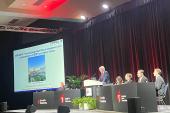STRONG-HF: Higher GDMT Doses Equal Better Outcomes
Even with rapid uptitration and close follow-up, fewer than half of patients reached the high doses: there’s more work to do.

Patients with acute heart failure (HF) who come closer to receiving optimal doses of guideline-directed medical therapies (GDMT) within a few weeks of the initial hospitalization have better outcomes than those receiving lower doses, according to a post-hoc analysis of the STRONG-HF trial.
Getting closer to optimal dosing was associated with significantly lower risks of both HF readmission/all-cause death and all-cause death alone at 180 days, as well as greater improvements in quality of life at 90 days, researchers led by Gad Cotter, MD (Université Paris Cité, INSERM, France), report in a study published online this week in JAMA Cardiology.
“Because the STRONG-HF trial showed the efficacy and safety of a regimen including both rapid titration of GDMT and close patient follow-up, the current analysis was important in suggesting that the main driver of the benefit of high-intensity care in the STRONG-HF trial was the uptitration of GDMT,” they write.
It also suggests, Cotter et al say, that when higher doses of GDMT can be tolerated by patients, “all efforts should be made to rapidly uptitrate to optimal doses of the three and (likely) four pillars of HF medications,” which include renin-angiotensin-aldosterone system (RAAS) inhibitors, beta-blockers, mineralocorticoid receptor antagonists (MRAs), and sodium-glucose cotransporter 2 (SGLT2) inhibitors. In STRONG-HF, more than 90% of the patients treated with high-intensity care were on at least 50% of the optimal doses of GDMT, on average, at 2 weeks.
As previously reported by TCTMD, the STRONG-HF trial showed that, compared with usual care, high-intensity care involving rapid uptitration of GDMT and close patient follow-up safely improved clinical outcomes and quality of life for patients with acute heart failure who were hemodynamically stable and had an NT-proBNP level above 1,500 pg/mL.
Not all patients in the high-intensity arm reached 100% of the optimal doses of GDMT by 2 weeks, however, and the current post-hoc analysis delved into the impact of lower dosing. Investigators focused on the 515 patients (mean age 62.7 years; 60.4% men) randomized to high-intensity care.
Patients were divided into three groups based on the mean percentage of the optimal doses achieved for the three classes of medications that made up GDMT at the time of the trial—RAAS inhibitors, beta-blockers, and MRAs—at 2 weeks. Overall, 7.6% achieved low doses (< 50% of optimal on average), 49.3% medium doses (50% to < 90% of optimal), and 43.1% high doses (≥ 90% of optimal).
Clinical outcomes at 6 months did not differ significantly across those categories, although each increase of 10% in the average percentage of the optimal dose achieved was associated with lower risks of HF readmission/all-cause death (adjusted HR 0.89; 95% CI 0.81-0.98) and all-cause mortality (adjusted HR 0.84; 95% CI 0.73-0.95). Similarly, gains in quality of life through 90 days, based on the EQ-5D visual analog scale, were greater in patients achieving higher doses of GDMT.
In terms of safety, adverse events through 90 days were less frequent among patients who were receiving higher doses of GDMT, although that appears to be related to the types of patients who could tolerate them. “Our study results suggest that patients with less stable clinical status (lower blood pressure, more congestion, and lower eGFR) before discharge were less likely to get full optimal medications at week 2,” Cotter et al note.
Commenting for TCTMD, Larry Allen, MD (University of Colorado School of Medicine, Aurora), lead author of an accompanying editorial in JAMA Cardiology, said that there is ongoing controversy about whether the relative underuse of GDMT for HF is primarily related to therapeutic inertia or due to true intolerances among patients.
In that context, this subanalysis of STRONG-HF shows that more than 90% of patients can achieve at least 50% of these medications’ optimal doses, with a small proportion who seem to be unable to. “It helps show that a lot of this [underuse] is probably inertia, but not all of it,” Allen said.
In terms of clinical implications, Allen—who provides care to patients with heart failure in both the inpatient and outpatient settings—said evidence from the overall STRONG-HF and this analysis “helps me feel reassured about being relatively aggressive about rapid intensification of guideline-directed medical therapies starting in the hospital.” The information on the relative safety of the approach and the impact on outcomes indicates, he added, “that that approach in my own clinical practice is probably warranted.”
Taking a broader view, Allen pointed to STRONG-HF as a solid piece of implementation science that helps bring new therapies into practice and guide clinicians on how to use them. “To me, STRONG-HF is an example of the importance of that kind of science to finish out the arc of scientific discovery,” he said.
Todd Neale is the Associate News Editor for TCTMD and a Senior Medical Journalist. He got his start in journalism at …
Read Full BioSources
Cotter G, Deniau B, Davison B, et al. Optimization of evidence-based heart failure medications after an acute heart failure admission: a secondary analysis of the STRONG-HF randomized clinical trial. JAMA Cardiol. 2023;Epub ahead of print.
Allen LA, Thompson JS, Stehlik J. STRONG-HF evidence for proactive, patient-centered prescribing. JAMA Cardiol. 2023;Epub ahead of print.
Disclosures
- The study was funded by Roche Diagnostics.
- Cotter reports receiving grants from Roche Diagnostics, Windtree Inc, and Corteria Inc and personal fees from Momentum Research outside the submitted work.
- Allen reports receiving personal fees from ACI Clinical, Boston Scientific, Cytokinetics, Novartis, Quidel, and UpToDate and grants from the National Institutes of Health and the Patient-Centered Outcomes Research Institute.





Comments